Content
- 1 Growing technology
- 2 Growing substrate
- 3 Growing tank device
- 4 Other production methods
- 5 Maggot farming
- 6 Industrial cultivation
- 7 Maggots business - home business with minimal investment (about other ideas with minimal investment here)
- 7.1 Stage one of creating a home business with minimal investment, preparing a room for growing maggots
- 7.2 Stage two of creating a home business without investment, food for flies and maggots.
- 7.3 Stage three business without investments at home, the formation of broodstock for growing maggots.
- 7.4 Stage four of creating a home business without investment, the very process of breeding and growing maggots.
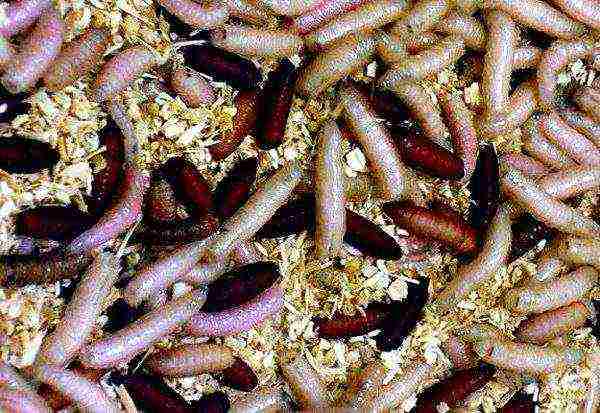
Maggot is an indispensable fishing tackle for most fans to sit with a fishing rod…. Scientifically, a maggot is called a fly larva. Three types of larvae can be found in fishing shops selling baits and baits for fish: the blue fly fly, the green fly, and the common housefly. The larvae of the latter are very small and not very convenient for baiting. The method of growing all species is exactly the same.
Growing technology
The industrial production of maggot is very specific and does not look as simple as it seems at first glance.
To obtain maggots, reliably closed rooms are used to exclude the penetration of extraneous flies and other unnecessary animals into them. The temperature in the room should be warm (+ 24-27 degrees) and constant. The flies are fed with sugar and other sweet food. Then pieces of meat are placed in the room, in which the flies lay their eggs in heaps. Within a day, a decent number of larvae is obtained from each heap: from 200 to 500 pieces.
The larvae are then placed in large containers up to 5 meters wide. Up to 50 liters of maggot can be obtained from one such container. The larvae are fed with meat from animals, poultry or fish. In just 7 days, a marketable maggot grows from a small larva. From 100 kg of meat, 50 liters of maggot can be grown. To make the maggot red (and by default, it is white), a special coloring agent is added to the meat - rhodamine B.
The final stage is the collection and sorting of maggots. As soon as the larvae have gained the desired weight, the pieces of meat rise above the collection containers, into which the maggots fall. Then the larvae are sifted through a sieve to remove impurities. The maggots, ready for sale, are placed in small boxes with sawdust and sent to the shelves of fishing stores.
How much can you earn?
If you find a wholesale buyer of maggots in large volumes, the business will bring a good income. In what other agricultural business can you grow 300-500 kg of finished, and far from cheap, product in 7 days from nothing?
The cost of one liter of maggot at the wholesale price is at least 900 rubles. In 7 days, from 1 ton of meat, we can get 500 liters of maggot. Within a week, the proceeds will amount to 450 thousand rubles.
In England, some farmers produce simply unrealistic volumes - up to 20,000 liters of maggot per week. If we translate it into our rubles, we get just cosmic profits: up to 18 million rubles. On an ordinary one, it is a fly larva. And you say the most profitable business is oil and coffee ...

Business pitfalls
While the business is profitable, the complexity of organizing it can be the stumbling block that will stop most aspiring entrepreneurs.
Here are just a few reasons that make industrial maggot growing challenging:
1. Strong smell.Fly larvae give off incredible amounts of sulfur dioxide and ammonia. This smell is not only very unpleasant, but also harmful to humans. It is for this reason that European countries have closed most of the farms that used the simplest technologies for obtaining maggot.
2. Labor force. Not everyone will agree to work in such a specific production. Therefore, either you will have to pay high wages, or be prepared for high staff turnover.
3. Where can I get raw materials for growing? Also a topical question. You will need to supply tons of meat weekly. It is expensive to buy fresh meat, you need to look for a product that is not entirely fresh. Perhaps, butchers, livestock complexes and other enterprises whose activities are related to the turnover of meat and poultry products will help in solving this issue.
4. Search for distribution channels for maggot. Selling 1000 liters of maggot is not easy at all. Here you have two ways to sell maggot: sell it to wholesale resellers at discounted prices, or arrange supplies to retail chains on your own. The second option is more profitable, but it will require huge labor and time costs. Good managers are essential. You will need to visit hundreds of fishing shops, and perhaps more than one major city. And not everywhere you will be welcomed with open arms. Most stores have been working with reliable maggot suppliers for a long time, and they are happy with everything.
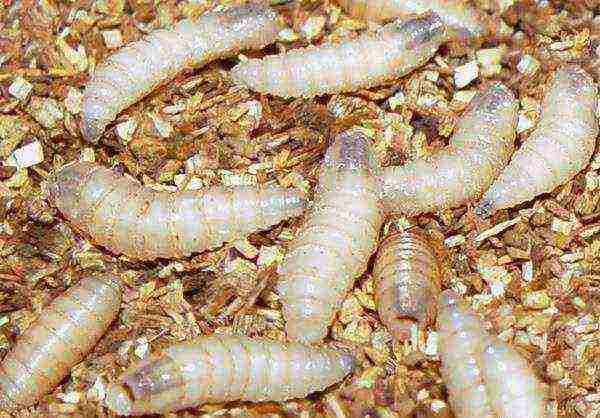
Maggot is one of the most popular baits when fishing for peaceful white fish. It is loved by roach, bream, crucian carp and many other carp. Now the acquisition of this bait is not a problem, the larvae of the blowfly are sold in almost any fishing store.
But many fishermen have mastered their own maggot production at home. Some grow them for themselves, others share with friends, others organize a small business on the larvae.
Growing technology
For yourself, whether the larvae are grown at home or in a large production for sale, the technology is the same. It differs only in the size of the premises, the amount of raw materials and the containers used.
Larval production can be divided into several stages:
- Fresh or starting to decay organic matter is placed in the container. The container itself is placed in a cool, shaded room, accessible for the penetration of a blue meatfly. Other fly species have smaller larvae.
- After a couple of days, flies lay eggs in heaps on the product.
- The container is closed with a lid with small holes made for air access.
- The larvae begin to grow, when the desired "marketable" size is reached, they are transferred to sawdust for cleaning from an unpleasant odor.
- After two days, the maggots are transferred again and transferred to storage. Keep the larvae in the refrigerator at home. If you miss the moment of moving them to a cold place, the larvae will pupate.
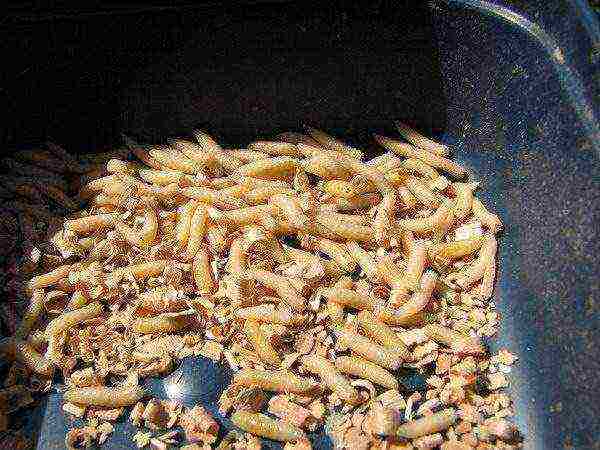
Growing substrate
Meat flies, and other flies, lay their eggs on organic matter that is beginning to deteriorate. Moreover, this is not only meat, but also many other products available at home, for example:
- meat offal: liver, lung, intestines;
- fish;
- eggs;
- cottage cheese;
- spoiled vegetables;
- bakery products.
Based on my own experience, I note that the largest "Michurin" larvae are obtained on rotten chicken eggs.
Growing tank device
How to grow maggots so that they are less exposed to unpleasant odors and sticky substrate? Many anglers easily solved this problem by constructing special maggots that can be used at home. They are easy to do at home with your own hands. And breeding larvae in them does not require frequent human intervention.
The maggot consists of three containers stacked one on top of the other.
- The upper container is used for storing meat or fish. It has a leaky cover and the same bottom.
- The average container also has a leaky bottom, wood shavings or large sawdust are placed in it with a layer of 5-7 centimeters.
- The lower container serves for clean maggots, sawdust is poured into it.
This construction works like this:
- We put the meat in the upper container and put it in a shaded place where the flies can find the bookmark.
- After two or three days, we check, and if we see that the flies have laid eggs, cover the top of the structure with a lid and put it in place.
- The hatched maggots grow and, having reached the market value, tend to pupate. They go down and penetrate through the holes into the middle container.
- Having passed through a layer of sawdust or shavings, they are cleaned and fall into the lower vessel, and from there they are removed and packed into jars, which are taken for fishing.
The entire production of maggots takes from a week to ten days, depending on the air temperature and the speed at which the fly fly lays its eggs on the prepared substrate.
Other production methods
Growing maggots at home can be simplified even more, and there are also original ways to breed them.
In a plastic bottle
Such a maggot is easy to make at home or right on the shore of the reservoir after fishing. We take a plastic bottle and cut it in half into two parts. In the lower part we pour a layer of sawdust 5-7 centimeters thick. We unscrew the cap and insert the upper part of the bottle into the lower part with the neck down.
In this case, the neck should not reach the sawdust for a couple of centimeters. Next, we put a dead fish, half-eaten egg, sausage or meat in the top and put the "larva production device" in the shade in a secluded place. Arriving on a fishing trip a week later, we take out the structure and select ready-made larvae.
Above the water
This growing method is also interesting. On a pond you frequent, choose a tree with a branch hanging over the water. Attach a jar with a hole in the bottom to this branch. Put a fish or a piece of meat in a jar.
The hatching maggots will fall into the water, and fish will be welded to this place. During fishing, you will only have to throw your tackle with maggots on a hook under a branch and catch fish accustomed to feeding on larvae. Make new bookmarks from time to time, then you will not need to worry about the bait all season.
From eggs
The largest larvae for fishing are obtained from raw or rotten eggs. One fisherman aptly described them as Michurin. The technology for the production of giant maggots is very simple, but it is better not to use it at home because of a very specific "aromatic" smell.
- We take a container and pour into it a layer of sawdust five to ten centimeters, for example, a low old saucepan.
- We set the eggs vertically in the sawdust, reinforce them with a bed of sawdust so that they do not fall.
- We break the top of the shell and wait for the arrival of the flies.
- Each egg hatches 20-30 larvae, but all of them are "Michurin", some of them can get out of the shell into sawdust.
Maggot farming
This can be called the private production of larvae for sale. Growing maggots on a large scale is possible only if there is a separate heated and well-ventilated room; at home in a city apartment, only a very enthusiastic and not squeamish person can afford it.
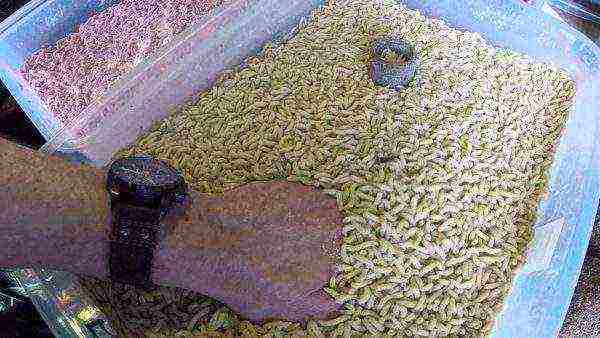
The premises are equipped with cages for keeping flies and containers for the withdrawal of maggots. Cages for keeping blue flies are wooden or metal frames covered with fine mesh or gauze, which are easily assembled by hand from wooden slats or profile metal. In the walls, special sleeves are arranged, like those used in biological laboratories, through which the cages are serviced: the installation and removal of containers with the substrate.
Maggots can be of various designs, but the principle described above is applied in them.However, part of the maggots is left for pupation and further recovery or growth of the blue blowfly population.
In the room for growing larvae, it is necessary to install a refrigerator for storing products ready for sale.
Industrial cultivation
The production of maggots for fishing on a large scale is essentially the same as the farming option described above. Only in production there is a greater scope, and even there they monitor the selection of flies to obtain better offspring.
It should be noted that in factories for the production of larvae, substances are used to color and flavor them.

Of course, you can paint maggots at home, but this requires both time and financial costs. In addition, sometimes there is simply not enough time for it. And some of the fishermen do not recognize dyed bait at all, considering painting an unnecessary whim, they say the fish bite on maggots so well.

Often, in search of business ideas, we go through many options, looking for “ours” among the mass of useful and not very information, but we very rarely look around, often finding ourselves in a situation that can be characterized by the proverb “You can see a speck in someone else's eye, but you can't see a log in your own ". I will start a little from afar, to get a complete picture both from the side of the consumer (read a potential buyer) and from the side of the business itself.
This summer turned out to be quite difficult on a personal level, on the one hand, roughness at work is associated with factors that I personally cannot influence, on the other hand, the same friction in other aspects of life, all this cannot affect the general condition. As a result, to put it mildly, they began to "give up" and urgently needed psychological relief, having gone through a lot of options came to the conclusion that fishing could become such an outlet. It sounds corny, of course, but the option turned out to be not bad, although I myself am not an experienced fisherman, it is very suitable for unloading. The result was, if not regular, then quite frequent trips both at paid rates and "public" reservoirs. As a fisherman said, I am without much experience and "inclinations" so that fishing is quite primitive using the simplest fishing rods and baits. Those who have come across fishing will not let it lie that a huge variety of baits and baits in fishing shops is very good, but for most types of fish (with the exception of the so-called "carp anglers"), the best option is a banal worm and maggot. That is, we use bait for the very "lure" of the fish, but the bait is still the same traditional worm and maggot. Of course, professional fishermen can smile and start a stormy dispute, but again, from the point of view of the overwhelming majority of the same fans, there is no better option.
Gathering every weekend on a fishing trip, I, like a huge number of the same "amateurs", began my trip with a trip to the store for a test and a trip to the "digging" of worms. Everything seems to be as clear and quite banal, until a real emergency happened (just kidding of course), once again going into the store, I heard the news - "There are no maggots and there will be no 10 days." The news is certainly not comforting, but I was personally interested, and in the end it turned out the following:
- - maggots for shops are imported from Poland (personally, I never even thought of this);
- - due to difficulties at the border, the next batch was simply stalled and a vacuum formed;
- - in our region, no one is engaged in self-breeding maggots.
Of course, the situation is funny if it were not so sad, by the way, by the next weekend, even an artificial maggot, which was positioned as a replacement, disappeared from store shelves. In addition, it was also impossible to "dig" the worms on their own, the heat did its job and the worms disappeared quite abruptly (in any case, in order to collect the required amount, it took half a day to search).We quickly sorted out the worms, began to buy from a friend who was engaged in their breeding, but with maggots it did not work out.
Actually, at this stage, I asked one simple and trivial question why is it profitable to breed maggots in Poland, taking into account transportation and "mandatory" payments at the border, but we do not?
After examining the situation and reading a little specialized literature describing the life cycle of flies, the maggot itself is a fly larva, I decided to check how it works. The goal set can be characterized by whether it is possible to create a business for breeding maggot at home. I will make a reservation right away that the experiment was staged not at home (I live in an apartment), but in the private sector using an enclosed space. Roughly speaking, a shed or other unused room with the ability to control the temperature is suitable for such purposes.
Maggots business - home business with minimal investment (about other ideas with minimal investment here)
Stage one of creating a home business with minimal investment, preparing a room for growing maggots
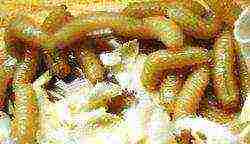
To begin with, I thought about a room for growing maggots and keeping the flies themselves. The main reason for most of the failures in home breeding of maggots for sale is precisely the incorrect content. The thing is that, despite the unpretentiousness of the fly, changes in the temperature regime greatly affect both the number of clutches and their size, the same thing happens with the larva itself. And to be honest, the less and slower they grow, the less money you earn.
Of course, I did not spend on full-fledged ventilation equipment, I managed with a number of household appliances and a temperature sensor with the function of automatically turning on and off the "constructed" system. By the way, it is ventilation that is one of the most expensive items of expenditure, as it turned out that the release of ammonia during the growth and development of fly larvae (maggot) is very impressive. Of course, as an experiment, no one bred the larvae in kilograms, but even the amount that was, gave a noticeable smell.
For the flies, they built two small boxes covered with a fine mesh, measuring a meter by one meter with a hard bottom, for the larvae we stocked up with several bags of sawdust and bought five plastic containers (I still don’t know why there are five).
Actually, the list of initial equipment for business and preparation ended there.
Stage two of creating a home business without investment, food for flies and maggots.
To be honest, after a long study of the "predilections" of flies, we went the simplest way, went to the nearest poultry farm and bought a dozen "crushed" chickens for a nominal fee. Immediately agreed with the foreman about the "systemic" supply of feed.
Stage three business without investments at home, the formation of broodstock for growing maggots.
In this matter, they approached from a purely scientific point of view and formed two herds at once:
- First, with the help of the simplest flycatchers in the area of the same poultry farm, they caught meat flies, while out of the total number they tried to choose only flies of a certain type. Of course, I am not an expert, but large-sized green flies were selected based on their appearance.
- The second was taken from the purchased maggots.
It is interesting that both the first and the second turned out to be very similar.
Stage four of creating a home business without investment, the very process of breeding and growing maggots.
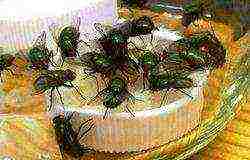
Without cheating for a long time, a chicken cut into several parts was placed in cages with flies, on which the flies quickly laid eggs.
Further, together with pieces of meat, eggs of flies were transferred into separate containers with sawdust. In which, in fact, there is a further development of maggots at home from the moment of hatching to the acquisition of a presentation.
At this stage, they faced a number of difficulties, ranging from the fact that the larvae stopped growing to the fact that they simply died, of course not all of them, but most of them.The fact is that in order to obtain the maximum result, it is necessary to provide the most comfortable conditions, and here you also need a certain humidity and prevent active rotting of the feed. To be honest, on the tenth try, certain patterns began to emerge. Of course, it is still far from ideal results, but clear successes are also evident.
In the end, after two months of active work on "selection" and the development of the correct technique, we got the first "harvest" in the amount of one hundred grams of maggots grown at home.
Stage five business ideas for breeding maggot at home.
Organization of product sales. With the sale, everything turned out quite simply in the nearest store they gave the grown maggots for sale. They buy a Polish product for real money, but here, as it were, on credit.
By the way, the maggots from the "green" flies were not very large, but they did not differ much from their Polish counterparts.
In addition, I can say that when the maggot was brought to marketable condition, it was placed in a refrigerator, where it was stored for a fairly long period of time.
Actually, as a result of the experiment, we were able to start growing maggots at home and even make money from this, although we are not talking about profit yet. Of course, this business has a number of both pros and cons:
The pros of a maggots home business.
- To create a maggot growing business, you need a minimum start-up capital.
- High turnover and profitability of the maggot breeding process at home. De facto, from the start (egg laying) to the receipt of the marketable maggot, it takes 7-8 days.
- The ability to create such a business at home.
Cons of a maggot growing business idea.
- The need to create your own technology, in fact, in the network you will not find a ready-made "recipe" for breeding, most of the processes need to be tried on your own.
- Certain aesthetic issues, not everyone can and will want to breed maggots in large quantities. Plus the very smell of "food" and the processes of vital activity of flies and maggots (at least the smell of ammonia).
As an epilogue
After evaluating all the pros and cons, we clearly identified the great prospects of this market and the very business idea of breeding maggots, now we have begun to experiment with other types of flies to ensure year-round cultivation (we grow the so-called housefly). Of course, it is very far from industrial scale, but I am seriously considering the possibility of creating a small farm, if you have experience in breeding, I will be glad to hear advice or share your experience, I will be very grateful.
Rate the article:
(0 votes, average: 0 out of 5)
≡ 5 September 2013;
Statistics show that every fourth man who is fond of fishing considers himself a successful fisherman and can spend quite a lot of money on equipment, for example, on bait and various accessories for fishing rods. For many lovers of this entertainment, it is not even the catch that is important, but the "process" itself.
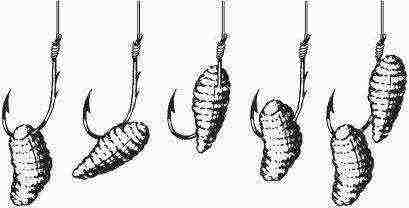 Breeding maggots at home and then selling them as bait is a business option that requires little or no start-up costs to start. This is a great business idea for fishing enthusiasts or people who have summer cottages and are looking for additional income.
Breeding maggots at home and then selling them as bait is a business option that requires little or no start-up costs to start. This is a great business idea for fishing enthusiasts or people who have summer cottages and are looking for additional income.
What are maggots
For experienced fishermen, this is not a mystery: they know very well why maggots are needed for fishing. Breeding them as a business is of more interest to those who want to start their own business with a minimum investment of start-up capital.
If you have a rich imagination and a heightened sense of disgust, you better start starting your own business in a different direction.However, in reality, maggots are just larvae of flies.
Most of the larvae of only some species of these insects are used for fishing:
- meat (blue);
- green;
- room (ordinary).
At the same time, the cultivation of maggots on an industrial scale and in conditions close to domestic ones is almost the same: for this, the process of rotting food remains is used.
Despite the fact that every year they come up with new bait for fish, none of them has yet managed to surpass maggots, which are something of a delicacy for fish.
It is enough to put a few pieces of meat or other food leftovers in a warm room where flies are inside, so that after a week you can collect maggots ready for sale.
How to equip a maggot growing room
The further the "base" where maggots will be grown is located from the living quarters, the less problems you will have with your neighbors. During growth, maggots give off an unpleasant smell of ammonia, and if there are 50, 100 or even more larvae, the smell will spread throughout the area and this, of course, will cause discontent among neighbors.
It follows from this that the premises that you need should be in the country or in the village. By the way, hereit will be possible to breed worms - they are also in great demand among fishermen.
Of course, in order to maximize your bottom line, you need to tackle creating conditions that are optimal for the emergence of quality maggots and increase their growth rate. Such conditions can be achieved in three ways:
- Temperature range: from 23 to 25 degrees Celsius must be maintained in the room constantly. Temperature "jumps" have a significant effect on the size of the larvae, although they are unlikely to be able to kill them;
- The air humidity in the room must be maintained at about 50-70%, since these are ideal conditions for the rapid reproduction of larvae;
- Ventilation of the room: ammonia, which is released by maggots, is not only harmful and unpleasant for people, but also toxic. However, you should not ventilate too much, as the larvae do not like this.
In addition to the above, you should carefully close the room so that extraneous flies and other insects that love to chew rotten meat do not enter it.
How maggots are bred
Flies are attracted to rotten meat (fish or poultry) not only by its pleasant taste for them, but also by the opportunity to lay their larvae in an ideal environment for this. Few people know that one fly can lay up to 300 larvae per day. Storing and breeding maggots, as a business (you can see the video a little below), in practice is carried out in large containers that are easy to make from plastic bottles.
Before you start growing maggots, you should stock up on a significant amount of sawdust, since the larvae require the absorption of excess moisture.
On an industrial scale, containers up to 5 m wide are used; for home conditions, they may be slightly smaller. From the container, you can get up to 60 liters of maggots, which grow to an adult state in a week and can be sold for bait.
For harvesting, the pieces where the maggots live are lifted over the prepared plastic containers and shaken a little. From this, the larvae fall, and after that they should be additionally sieved to clear them. After that, maggots wait in the wings in sawdust, which is poured into bottles so that they remove excess moisture.
There is alsosummer economical way of breeding maggots... For this, the usual size bottles are used, which must be cut so that the lower part is almost twice as large as the upper one. The cork is rolled up and the cut off top is inserted into the bottom. At the top is food, which will lure flies, and sawdust is poured into the bottom. Adult larvae will get there, but it should be borne in mind that this method is significantlyimpairs the quality of adult maggots.
Why do you need food for flies and how to feed them
For those who are interested in how to grow and store maggots at home, it is important to clearly understand that in order for adult larvae to be healthy and have a "marketable" appearance, the flies need to eat well enough.
Often, leftovers, boiled eggs, flour and dairy products and rotten vegetables are used for feeding, but meat is undoubtedly the best effect.
Also, flies with pleasure and with benefits for their health eat offal and other parts that remain after cutting any animals. The same food, but in a crushed form, you can feed the larvae themselves.
However, do not think that you will have to buy kilograms of meat and wait until it deteriorates: in this way, instead of the expected profit, only losses will await you.
To breed fly larvae, you will have enough leftovers from butchering animal carcasses, dead chickens and chickens from poultry farms or fish. Finding the source of this "good" will not be a problem.
You can arrange to have some of your waste left at nearby farms, poultry farms, or simply meat processing plants. By law, such remains should be buried, but in practice, businesses are usually happy to get rid of these hassles and give you second-rate or substandard goods.
Maggots can be sold on their own by opening in a fishing store, on the Internet, or sold to large chains.
How to keep maggots
As mentioned above, maggots can be sold in a week. When this period has passed, they should be collected and stored, otherwise they will be buried in sawdust and pupate, and then flies will hatch from them. You can collect the larvae with your gloved hands, or you can sift the sawdust through a sieve.
The larvae must be placed in jars with fresh (always wet) sawdust and placed in the refrigerator.At temperatures from -4 to -2 degrees, maggots will be stored for about a month..
The sale of maggots for fishing should be realized at this time, since after it the larvae will not be of interest to the fish, which means that they will also lose their attractiveness for fishermen.
You should know thatmaggots can change their color depending on nutrition... From the protein they turn white (although this is their main color), from the yolk they acquire yellowness, and from the special food coloring rhodamine B they turn red. This property can be successfully used, knowing well the demand of their consumers.You can change not only the color of the larvae, but also their smell... For example, if you add anise oil to sawdust, maggots acquire a noble smell, which not only is more pleasant to fishermen, but also attracts the attention of fish.
How to organize sales
Despite the fact that it is not at all difficult to grow maggots, this niche in our country is not yet occupied at all. Many fishing shops buy this product abroad, while additionally paying for its delivery.
Maggots can be sold independently by opening a smallfishing store in a busy area or even on the Internet, or you can offer your goods in bulk to large stores of a suitable profile. You can give your goods to other stores "for sale", and what will come back to you later, use as feed for new maggots.


